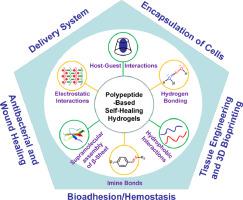Acta Biomaterialia ( IF 9.7 ) Pub Date : 2020-07-04 , DOI: 10.1016/j.actbio.2020.07.001 Lili Cai 1 , Sa Liu 2 , Jianwei Guo 1 , Yong-Guang Jia 3

|
Self-healing hydrogels can heal themselves on the damaged sites, which opens up a fascinating way for enhancing lifetimes of materials. Polypeptide/poly(amino acid) is a class of polymers in which natural amino acid monomers or derivatives are linked by amide bonds with a stable and similar secondary structure as natural proteins (α-helix or β-fold). They have the advantages of nontoxicity, biodegradability, and low immunogenicity as well as easy modification. All these properties make polypeptides extremely suitable for the preparation of self-healing hydrogels for biomedical applications. In this review, we mainly focus on the progress in the fabrication strategies of polypeptide-based self-healing hydrogels and their biomedical applications in the recent 5 years. Various crosslinking methods for the preparation of polypeptide-based self-healing hydrogels are first introduced, including host-guest interactions, hydrogen bonding, electrostatic interactions, supramolecular self-assembly of β-sheets, and reversible covalent bonds of imine and hydrazone as well as molecular multi-interactions. Some representative biomedical applications of these self-healing hydrogels such as delivery system, tissue engineering, 3D-bioprinting, antibacterial and wound healing as well as bioadhesion and hemostasis are also summarized. Current challenges and perspectives in future for these “smart” hydrogels are proposed at the end .
Statement of Significance
Polypeptides with the advantages of nontoxicity, biodegradability, hydrophilicity and low immunogenicity, are extremely suitable for the preparation of self-healing hydrogels in biomedical applications. Recently, the researches of polypeptide-based self-healing hydrogel have drawn the great attentions for scientists and engineers. A review to summarize the recent progress in design and biomedical applications of these polypeptide-based self-healing hydrogels is highly needed. In this review, we mainly focus on the progress in fabrication strategies of polypeptide-based self-healing hydrogels and biomedical applications in recent five years and aim to draw the increased attention to the importance of these “smart” hydrogels, facilitating the advances in biomedical applications. We believe this work would draw interest from readers of Acta Biomaterialia.
中文翻译:

基于多肽的自修复水凝胶:设计和生物医学应用。
自修复水凝胶可在受损部位自我修复,这为延长材料的使用寿命开辟了一种迷人的方式。多肽/聚氨基酸是一类聚合物,其中天然氨基酸单体或衍生物通过酰胺键连接,具有与天然蛋白质(α-螺旋或β-折叠)稳定且相似的二级结构。它们具有无毒,可生物降解,免疫原性低以及易于修饰的优点。所有这些特性使多肽非常适合用于生物医学应用的自愈水凝胶的制备。在这篇综述中,我们主要关注近五年来基于多肽的自修复水凝胶的制备策略及其生物医学应用的进展。首先介绍了用于制备基于多肽的自愈水凝胶的各种交联方法,包括主体-客体相互作用,氢键,静电相互作用,β-折叠的超分子自组装以及亚胺和的可逆共价键以及分子多重相互作用。这些自修复水凝胶的一些代表性生物医学应用,例如递送系统,组织工程,3D生物打印,抗菌和伤口愈合以及生物粘附和止血,也得到了总结。最后提出了这些“智能”水凝胶的当前挑战和前景。亚胺和的可逆共价键以及分子的多重相互作用。这些自修复水凝胶的一些代表性生物医学应用,例如递送系统,组织工程,3D生物打印,抗菌和伤口愈合以及生物粘附和止血,也得到了总结。最后提出了这些“智能”水凝胶的当前挑战和前景。亚胺和的可逆共价键以及分子的多重相互作用。这些自修复水凝胶的一些代表性生物医学应用,例如递送系统,组织工程,3D生物打印,抗菌和伤口愈合以及生物粘附和止血,也得到了总结。最后提出了这些“智能”水凝胶的当前挑战和前景。
重要声明
具有无毒,可生物降解,亲水性和低免疫原性优势的多肽非常适合在生物医学应用中制备自愈水凝胶。近年来,基于多肽的自修复水凝胶的研究引起了科学家和工程师的极大关注。迫切需要对这些基于多肽的自修复水凝胶在设计和生物医学应用方面的最新进展进行总结。在这篇综述中,我们主要关注近五年来基于多肽的自修复水凝胶的制备策略和生物医学应用的进展,并旨在引起人们对这些“智能”水凝胶重要性的日益关注,以促进生物医学的发展应用程序。


























 京公网安备 11010802027423号
京公网安备 11010802027423号